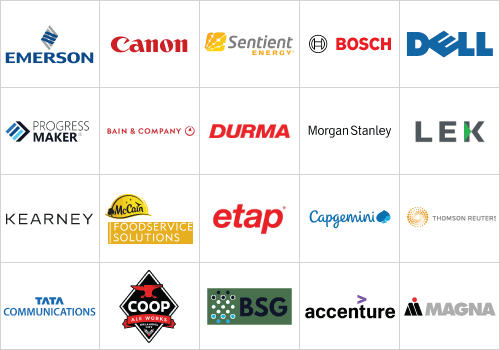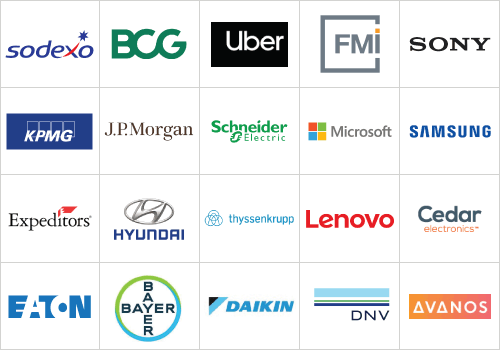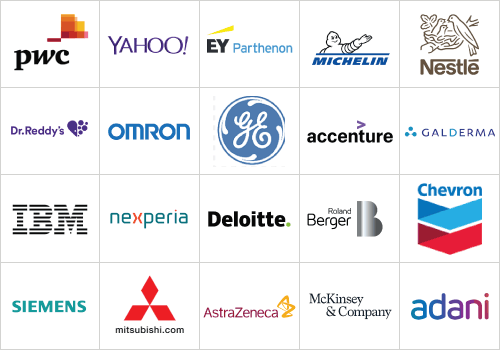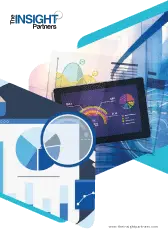The Insight Partners has published over 8000+ market research reports across 13+ industry segments, providing an exhaustive overview of the market.
About Us
Welcome to The Insight Partners! Your trusted partner for comprehensive market research and actionable insights that drive informed business decisions. Established in 2015 on the tenet that data is the cornerstone of strategy, we are committed to delivering high-quality, accurate, and fast market intelligence that empowers organizations across industries to confidently traverse complex markets.
The Insight Partners is a leading global market research and consulting firm specializing in providing detailed and forward-looking research reports, industry insights, and data-driven analysis. With a team of experienced market research analysts, we have built a strong reputation for providing accurate insights that help businesses thrive in a dynamic and rapidly shifting marketplace.



Why Choose Us
Expert-driven insights
Our market research, in-depth knowledge, and thorough analysis can translate into actionable guidelines for your decisions.
Tailored analytics
We cater to your market research demands by developing tailored research solutions.
Dedicated to excellence
The Insight Partners’ primary objective is to consistently demonstrate professionalism and uphold ethical standards in every action performed.
Versatile offerings
Our market research report offerings span from individual to enterprise-wide scopes, addressing the majority of market research evaluations and decision analytics requirements.
Checkout Our Products
Size and Forecast (2021 - 2031), Global and Regional Share, Trend, and Growth Opportunity Analysis Report Coverage: By Component (Engine MRO, Avionics MRO, Airframe MRO, Cabin MRO, Landing Gear MRO, and Others), Aircraft Type (Fixed Wing and Rotary Wing), End Use (Commercial and Military), and Geography
Size and Forecast (2021 - 2031), Global and Regional Share, Trend, and Growth Opportunity Analysis Report Coverage: By Product Type (IPTV, Satellite, Cable, and Others), Content Quality (Standard Definition (SD), High-Definition (HD), and 4K), and Geography
Size and Forecast (2021 - 2031), Global and Regional Share, Trend, and Growth Opportunity Analysis Report Coverage: By Component (Solutions and Services), Grid Type (Medium Voltage Grid, High Voltage Grid, and Low Voltage Grid), Vertical (Utilities, Industrial, and Commercial), and Geography
Size and Forecast (2021 - 2031), Global and Regional Share, Trend, and Growth Opportunity Analysis Report Coverage: By Component (Software, Hardware, and Services), Deployment (Cloud and On-Premises), Organization Size (Large Enterprises and SMEs), Industry Vertical (IT and Telecom, BFSI, Healthcare, Manufacturing, Retail and E-Commerce, Automotive, and Others), and Geography
Size and Forecast (2021 - 2031), Global and Regional Share, Trend, and Growth Opportunity Analysis Report Coverage: By Chiller Type (Water Cooled Chillers and Air Cooled Chillers), Process (Continuous Flow Chillers and Immersion Chillers), Application (Industrial Manufacturing, Food and Beverage Processing, Medical Equipment, and Others), and Geography
Size and Forecast (2021 - 2031), Global and Regional Share, Trend, and Growth Opportunity Analysis Report Coverage: By Product Type (Omni-Directional Antenna, Semi-Directional Antenna, and Highly-Directional Antenna), Omni-directional Antenna (Monopole Antenna, Dipole Antenna, Helical Antenna, and Others), Semi-directional Antenna (Patch, Panel, Sector, and Others), Highly-directional Antenna (Parabolic Dish, Grid Antenna, Yagi-Uda Antenna, and Others), Technology (5G, 4G or LTE, Wi-Fi, Bluetooth, GPS or GNSS, and Others), Industry (Telecommunications, Consumer Electronics, Mining, Aerospace and Defense, Industrial, Automotive and Transportation, and Others), and Geography
Size and Forecasts (2021 - 2031), Global and Regional Share, Trends, and Growth Opportunity Analysis Report Coverage: By Application (Cold Storage warehouses, Industrial Installation, Heavy Commercial Refrigeration, Transport Refrigeration, Automobiles, Others) , and Geography (North America, Europe, Asia Pacific, and South and Central America)
Size and Forecasts (2021 - 2031), Global and Regional Share, Trends, and Growth Opportunity Analysis Report Coverage: By Component (Solution, Service); Industry Vertical (Automotive, Aerospace, Retail, Healthcare, Food and Beverages, Others) , and Geography (North America, Europe, Asia Pacific, and South and Central America)
Size and Forecasts (2020 - 2030), Global and Regional Share, Trends, and Growth Opportunity Analysis Report Coverage: By Component [Hardware (Sensor, Microcontroller, Processors and ASICS, Memory, and Others) and Software], Functionality (Real-Time Embedded Systems, Standalone Embedded Systems, Networked Embedded Systems, and Mobile Embedded Systems), and Application (Automotive, Telecommunication, Healthcare, Industrial, Consumer Electronics, and Others)
Forecast to 2028 - COVID-19 Impact and Global Analysis By Application (Food and Beverage, E-commerce, Consumer Durables, Electrical and Electronics, and Others)
to 2025 - Global Analysis and Forecasts By Product (Platforms, Services and Consumables); Application (Diagnostics, Drug Discovery, Precision Medicine, & Other Applications); & End User (Academic & Research Institutes, Pharmaceutical & Biotechnology Companies, Hospitals Clinics, & Other End Users) and Geography
Value Chain Analysis
Value chain analysis is a powerful tool to determine a problem in the supply chain ecosystem or judge the effectiveness of the processes in a structured way. We provide a deep dive analysis on value chain covering a plethora of support and primary activities such as technology development, component manufacturing, research & development activities, infrastructure, operations, inbound logistics, marketing & sales, and others.
Vendor Ecosystem Analysis
Understand the synergies within the network of vendors to identify and further strengthen relationships complementing your business growth. Benchmark your competitors sourcing strategy to improve creativity and innovation to lower the cost of production or expand your vendor list.
Company Benchmarking
We help you create a yardstick to evaluate your competitor providing better understanding of your competitive landscape. Identify your strengths and weaknesses, set performance goals with better understanding for your competition.
Go-To-Market Strategy
Our consultants provide a perfect mix of go-to-market strategy ranging from marketing mix, customer analysis, market selection, and a host of other market strategies. A pinpointed, well executed market strategy can create growth multipliers through a successful implementation.
Identifying market potential and opportunities
The Total Addressable Market (TAM) is an essential assessment and analysis to identify the untapped revenue pockets. Our consultants can help you unearth possible expansion opportunities such through – demand analysis, consumer voice, geographic expansion, product line expansion, and building competitive advantages for faster scalability.
Climate Change and ESG
Climate change is the greatest challenge of our generation – and corporates around the world are stepping up towards implementing ambitious net zero commitments. We help clients identify and measure climate innovation, sustainability solutions and track energy transitions that the businesses are embracing to achieve business sustainability strategy.
Our Services
The Insight Partners delivers a comprehensive analysis of the primary industry research and trends that influence the global/regional market. This valuable knowledge assists organizations in formulating effective long-term strategies. Knowing the competitive dynamics and the prevailing market trends helps businesses make informed decisions to strategically drive growth.

Syndicate Research
Our syndicate research reports are based on extensive research and analysis and cover various aspects of an industry or market. These research reports provide a thorough analysis of industry trends, competitive landscape, market dynamics, and key players.
Our clients find these reports critical to their strategic planning, enabling them to make informed decisions regarding market entry, investment, product development, and other strategic initiatives.
The syndicate research provides a detailed description of the industry, including its size, growth rate, segmentation breakdown, competitive landscape, forecast, trends, and SWOT analysis.
View ReportsIntelligence Cloud - eInsights
As industry participants explore timely and accurate insights to support their planning and strategies, we strive to provide meticulous market data, forecasts, and competitive analysis of the global, regional, and local industries, companies operating in them, and economies they serve.
eInsights platform is an interactive marketplace of trusted analytics, expert insights, dynamic updates, and analyst connect. The interactive dashboard provides analytics and insights at your fingertips that seamlessly work together through the integration of databases and ease of navigation. Clients can seek information and insights by industry, report title, target company, and geography of their interest.
Using secure login credentials, you can seamlessly navigate the cloud platform to access the information you seek for your business plan. Whether you are looking for specific data points in a particular area or an overview of a broader market, our platform delivers it all with ease.
Explore More

Custom Solution
We believe the effective solutions should be as exclusive as your challenges. Our solution services are customized to empower your business with personalized strategies that drive results and foster growth.
With our customized solutions, you will find complete data from in-depth market research, including company profiles, competitive landscapes, and market insights for the desired countries, in the format preferred by you. These customization solutions give you actionable insights relevant to your business strategy, which are reliable and aligned.
Rapid deployment, tailored fit, expert support, and scalable options are some of the key benefits that our custom solutions bring to the table. Contact us now to see how we can help you achieve efficiency and effectiveness in your goals.
Customize your ReportTestimonials
Why We Are Different
8000
Projects Completed4000
Satisfied Customers250
Analysts13
Industry VerticalsUnique solutions, made to match your goals.
“Contact us to learn more about our innovative market intelligence offerings that can help you achieve your critical business goals and objectives.”


